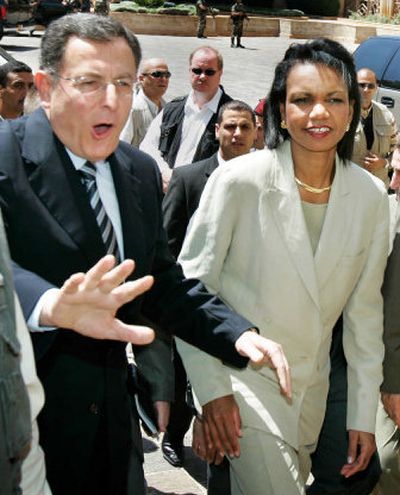Israeli push claims hilltop

BEIRUT, Lebanon – Backed by tanks, Israeli troops battled their way to a key Hezbollah stronghold in south Lebanon on Monday, seizing a hilltop in heavy fighting and capturing two guerrillas. The U.S. completed its evacuation of 12,000 Americans and said it would switch to bringing in humanitarian aid.
On the 13th day of Israel’s offensive, its forces moved one step deeper into Lebanon as U.S. Secretary of State Condoleezza Rice made her first diplomatic foray since the conflict began – and immediately met resistance.
The tangled knots in the negotiations meant fighting was likely to drag on just as the pace of Hezbollah rockets raining down on Israel shows no signs of letting up despite the aerial bombardment of its positions. Air power alone is proving insufficient to rout the guerrillas, who are tough opponents on the ground as well. Mideast observers say Hezbollah only has to remain standing – not beat Israel – to emerge victorious in Arab eyes.
Rice paid a surprise visit to Beirut on the way to Israel, trying to push a plan that would call for a cease-fire simultaneous with the deployment of international and Lebanese troops into southern Lebanon to prevent Hezbollah attacks on Israel.
Parliament speaker Nabih Berri, a prominent Shiite Muslim who has been negotiating on behalf of Hezbollah, rejected the idea and said a cease-fire should be immediate, leaving the other issues for much later. Western-backed Prime Minister Fuad Saniora took a similar stance and complained to Rice about the destruction wreaked by Israel.
Israel “is taking Lebanon backward 50 years and the result will be Lebanon’s destruction,” he told Rice, the prime minister’s office said.
Israel appeared to be easing bombardment in populated areas and roads in Lebanon that has killed hundreds, displaced as many as 750,000 and dismembered the transportation network. Instead, it appeared to be focusing its firepower on Hezbollah at the front. Beirut saw no strikes all day in apparent deference to Rice’s visit.
Lebanese security officials reported three civilian deaths, without specifying where they occurred. Thirty strikes in and around towns and on roads were reported by security officials and Lebanese media – down from 37 the day before.
The numbers do not include strikes on Hezbollah positions that are not in populated areas. Israel reported 270 strikes on Sunday, suggesting that a large number were in more isolated regions.
Still, Hezbollah was able to launch 80 rockets into northern Israel, wounding 13 people, a rate only slightly lower than in past days.
Israel’s overall death toll stands at 40, with 17 people killed by Hezbollah rockets and 23 soldiers killed in the fighting. Sixty-eight soldiers have been wounded, and 255 civilians injured by rocket fire, officials said.
On the Lebanese side, security officials said 384 people had been killed, including 20 soldiers and 11 Hezbollah guerrillas.
At the front, Israeli ground forces waged a fierce battle Monday with guerrillas dug in at the closest large town to the border, Bint Jbail, known as “the capital of the resistance” for its vehement support of Hezbollah during Israel’s 1982-2000 occupation of the south.
Nearly constant gunfire and explosions could be heard, and large plumes of gray smoke rose over the area. Israeli tanks and armored bulldozers entered the fray as guerrillas fought back with anti-tank missiles and mortars. Backed by an intense artillery barrage, troops seized a hilltop inside the town, but the rest of Bint Jbail remained in the hands of up to 200 Hezbollah guerrillas, military officials said.